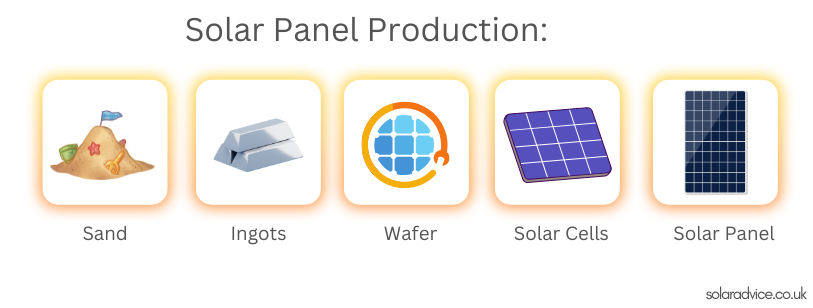What are modern solar panels made of? Here we explore the most commonly used materials and how the exact components may vary depending on the type of solar panel.
Solar panels are comprised of solar cells that contain the semiconducting material e.g. silicone, as well as a whole host of other components that go together to create the solar panel’s final structure.
More precisely around 95% of photovoltaic (PV) cells i.e. the part that harnesses the light rays and converts it to electricity are made from silicone, with the remaining 5% using experimental materials.
This is not only cheap because silicon is the second most abundant substance on the planet but it is highly efficient and long-lasting. You can expect solar panels to last a minimum of 25 years.
Pro tip: Avoid upsells and confusing packages—choose a provider with a clear, fixed-price quote that won’t change. Heatable, a Which?-approved solar installer, offers transparent pricing with no surprises.
There are 3 main types of solar panels that are most commonly used today, these include the following:
- Monocrystalline solar panels – that use mono-silicone cells
- Polycrystalline solar panels – that use polysilicon cells
- Thin film solar panels – that can use a range of different materials

All of these can be made from silicone, but the exact components may be slightly different for all three, and of course, there will be variations between different solar panel manufacturers.
Materials in Solar Panels
The following materials are found in most solar panels:
- The photovoltaic (PV) cells that contain the semiconducting materials e.g. silicone
- Boron – boron is often added to the cells to increase efficiency
- A frame – to provide structural integrity
- A glass sheet that protects the front of the cells
- A polymer-based material on the back provides protection
- Ethylene vinyl acetate – a glue used to combine the components
Get a free estimate for your solar with the experts at Heatable:
- It’s free, easy, and without obligation
- Compare quotes & get the best prices
- Save up to £660 per year

What Are Solar Cells?
The main component of solar panels is the photovoltaic (PV) cells, which contain semiconducting materials i.e. silicone that convert sunlight to electricity.
These solar cells are organised into a large frame known collectively as a solar panel.
Monocrystalline Solar Cells
Monocrystalline uses mono silicone cells that are manufactured from a single crystal of silicon.
In turn, this means that they only use a single crystal and so the electrons that generate the electricity have more room to move.
In the manufacturing process, all four sides of the crystal are cut, which gives them a characteristic appearance and the highest efficiency of any other type.
However, this process is also quite wasteful and so they tend to be the most expensive type.
Polycrystalline Solar Cells
Polycrystalline solar panels utilise multiple silicon crystals so the electrons have less space to move in compared to monocrystalline, hence they are less efficient.
They do not require all sides of the crystal to be cut and so it is considered a less wasteful process.
Instead, polycrystalline uses poly silicone cells and is made by melting several silicone crystals together, hence the names mono and poly.
The actual solar panel is made up of these cells being soldered together in a matrix-like structure.
Solar panels are typically comprised of either 48, 60 or 72 cells.
Once the right number of cells has been put together, a thin layer of glass goes onto the sun-facing side as well as polymer-based material on the back. This is to protect the panels from dirt or water.
Finally, a frame goes on using EVA (ethylene vinyl acetate) a glue that binds everything together.
It is important this is done to a high standard to protect against harsh weather and any other factors that could damage the cells.
Related solar guides:
- How many solar panels do you need?
- Smart Export Guarantee
- Can you install solar panels in a conservation area?
- Best 4kw solar system with battery storage
- Sunshine hours map UK
- Best Solar Panels
- Solar panel output calculator
What are Thin Film Solar Panels/Cells Made of?
Unlike Monocrystalline and polycrystalline solar cells, thin film solar cells can be made from several different materials.
Thin film solar panels are the least efficient on average, which can range between 7% to 13%.
These may include any of the following:
- Amorphous silicon – non-crystalline silicon which is much easier to produce than mono and poly.
- Cadmium telluride thin-film – made from a special chemical compound called Cadmium Telluride which is good at capturing and converting sunlight. The problem with this type is that it is rare and toxic meaning it needs special precautions when manufacturing it.
- Copper Indium Gallium Selenide – these cells are made by placing layers of Copper, Indium, Gallium, and Selenide on top of each other to create a powerful semiconductor that can efficiently convert sunlight into energy.
Why is silicone commonly used to make solar cells?
Silicon is the most common semiconductor used to make solar cells today.
Making up 95% of panels, silicon provides a low-cost, efficient material that has a long life.
Modules made of silicone are expected to last 25+ years while still providing 80% of their original power.
Other benefits of silicon include it being a non-toxic, stable material. It’s readily available and it can work at over 20% efficiency.
How do silicone solar cells then create energy?
Silicone solar cells create energy when particles of light hit the thin layer of silicon on the top of the panels, knocking electrons off the silicon atoms.
This charge creates an electric current that is captured by the wiring in the solar panel.
This is called a ‘direct current’ which is then converted into an ‘alternating current’ by an inverter.
For reference, an alternating current or AC is the type we use for our household appliances.
Why is boron added to solar cells?
Boron is now more and more often added to solar cells. Boron works with silicon to optimize the energy generated by sunlight.
Simply put, boron reacts with silicon changing its atomic structure. The process creates surplus electrons which produces electricity.
Research shows that if you add just 1% boron to silicon-based semiconductors, then the solar panels can absorb up to 10 times more light than before.
This means they can work better under low-light conditions or on cloudy days when there isn’t much sunlight available.
Boron is also an environmentally friendly product when used in solar farms as it reduces the destruction of organic matter such as algae and plankton that live in the water surrounding them.
What is the Difference Between the Three Types of Solar Panels?
Monocrystalline Panels
Monocrystalline is cut from a single source of silicone whereas polycrystalline is cut from multiple.
This makes monocrystalline solar cells much more efficient and more effective in high heat, low light situations but is a less sustainable way to produce cells compared to poly cells.
Monocrystalline also produce the most waste. This is because they are cut from a single square of silicone, meaning the corners need to be shaved off.
Though this shape and their uniform black look do make them more desirable to look at, which can be a deciding factor to some buyers.
Polycrystalline Panels
Polycrystalline cells are made by moulding serval small pieces of silicone together, hence the reason there is very little raw waste from this process.
You’ll recognise this type of solar panel from the blue colour.
If you look closely the texture and uneven colours will reveal the small pieces of silicone bound together.
It’s these imperfections that make these cells slightly less efficient which is reflected in the price.
Thin Film Solar Panels
Thin film solar panels are cheaper than mono and poly but are also the least efficient.
They shouldn’t be discounted though. They may be the least efficient but they are the cheapest and most sustainable way of manufacturing solar cells.
This also makes it good for large-scale solar farms or commercial properties where space isn’t an issue.
What’s more, its thin structure, as the name suggests, makes it possible to put it onto plastic and create a flexible solar panel.
This is good for motor homes or mobile uses where it is not possible to mount on a flat surface.
Get a Free Solar Quote Today
If you are interested in having solar panels installed, you’ll want to get an installer to provide you with a custom quote based on your particular circumstances.
For more information, please get in touch and we’d be happy to help.
